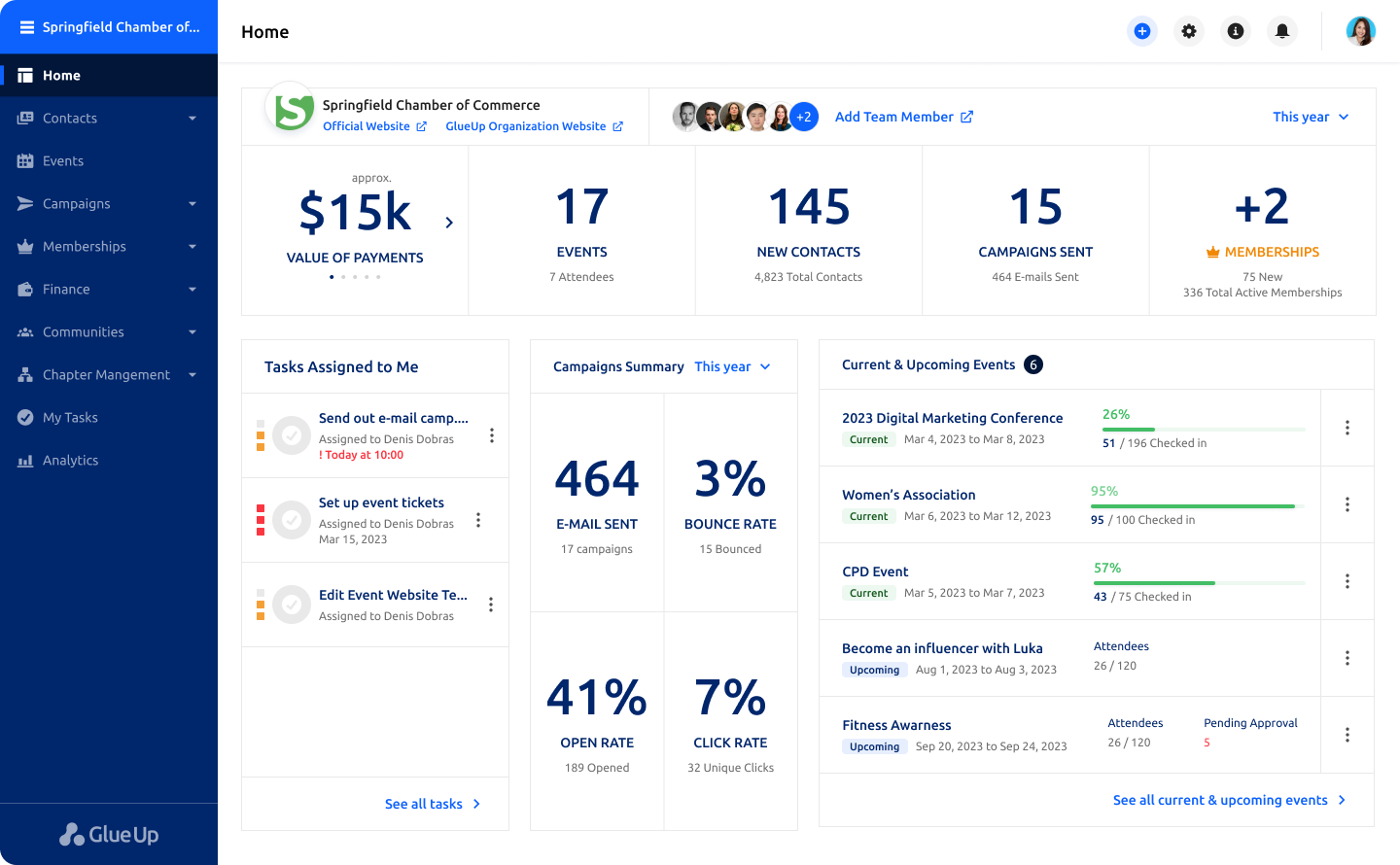
Managing a Chamber of Commerce can be challenging, especially when faced with the need to generate significant revenue. In this situation, thoughts to increase membership fees may arise, but doing so without any additional value can risk damaging both your credibility and that of the chamber.
This blog aims to address all the complexities by exploring strategic approaches. We will explore thoughtful considerations in setting membership fees and how to manage these financial aspects skillfully.
Read on to discover practical tips for maintaining a thriving Chamber of Commerce while promoting trust and value within your business community.
Key Takeaways
- Increasing Chamber of Commerce membership fees without increasing corresponding values can damage the credibility of your Chamber.
- Before setting the membership fee, you must consider the scale of businesses and the industry in which most of your members operate in
- Joining a Chamber of Commerce increases credibility, and customers tend to buy more from that business.
- The more you provide value and benefits to your members, i.e., networking opportunities, marketing, and discounts, the more they are loyal to your chamber and even ready for higher fees.
- Glue Up's membership management software offers multiple features including centralized payments, payment tracking, automatic invoicing, and financial reporting to efficiently collect and manage the Chamber of Commerce membership fees.
First Things First: What Are Chamber of Commerce Membership Fees
Let's take a closer look at the Chamber of Commerce membership fees and their key fundamentals. These fees serve as the lifeblood that fuels the chamber's day-to-day operations. They are the financial contributions made by members, pooling resources to sustain the chamber's activities.

In return for these fees, members gain access to a number of services and programs provided by the chamber.
These offerings can include:
- Networking events
- Business development opportunities
- Educational programs
- Advocacy initiatives
- Various support services
The fees, therefore, form a primary support, allowing the chamber to create a dynamic and supportive environment for its members.
How Are Chamber of Commerce Membership Fees Used?
The membership fees collected by the Chamber of Commerce are primarily allocated to support specific causes that directly benefit members and the broader business community.

These funds are mainly utilized for the following purposes:
Networking Opportunities
Most of the membership fees are dedicated to creating networking opportunities, as local business owners joining a Chamber of Commerce anticipate opening new doors for their enterprises.
This allocation supports a range of crucial activities, including networking events, workshops, and seminars. Additionally, members benefit from leadership development programs, an online member directory, and referral services. Participating in such events allows business owners to present their ventures to the entire community, building potential client connections and collaborations.

Arranging effective networking events locally is challenging, but the results are consistently satisfactory. According to Bizzabo's June 2023 report, 83% of organizers and 78% of attendees believe that in-person conferences provide the ideal networking environment.
Given the significant impact of these networking opportunities, members find considerable value in such engagements, demonstrating a willingness to invest even more for enriching networking experiences.
Community Support for Businesses
The Chamber of Commerce offers invaluable community support to businesses, making it a highly sought-after affiliation. Business owners are eager to be part of this chamber because the fees they pay are strategically utilized to provide them with various benefits.

Firstly, they get exclusive discounts and access to goods, commodities, or services at more favorable prices. This cost-saving advantage increases the overall value of chamber membership.
Moreover, the fees help in enabling a sense of community responsibility. In case any member faces an issue, the entire community comes together to address and resolve the matter, creating a supportive and collaborative environment.
The Chamber of Commerce also provides funds to ensure valuable resources to businesses and owners. Also, they get access to business directories and market research reports, empowering businesses to stay well-informed and make informed decisions.
These resources play a crucial role in helping businesses navigate challenges and opportunities effectively.
Business Exposure
Another significant area where membership fees are utilized is in providing business exposure. The Chamber of Commerce is dedicated to promoting and showcasing its existing and new members to a wider audience.
The chamber employs various strategies to achieve this, including PR releases and advertisements on social media platforms. Moreover, if a member requires additional support, the chamber offers sponsorships to amplify their visibility further.
Beyond promotion, the chamber facilitates business growth by providing a stage for its members. This platform enables members to scale their operations and generate increased revenue.
The collected fees play a significant role in funding these initiatives, ensuring that businesses affiliated with the chamber receive the exposure and support needed to thrive in a competitive market.
Access Local Expertise
The fees collected from members play a crucial role in providing them with access to valuable local expertise. This access extends to a diverse range of resources, including:
- Expert Panels and Forums
- Collaboration with Local Institutions
- Webinars and Seminars
- Member Directories and Online Platforms
- Training sessions
These resources are designed to empower businesses, offering them insights, knowledge, and networking opportunities essential for success.
Particularly beneficial for business operations, these resources contribute significantly to facilitating sales, purchases, and revenue generation.
Expert Panels and forums provide a platform for industry-specific discussions and insights, and collaboration with local institutions offers partnerships and growth opportunities. Workshops and training sessions equip members with the skills needed to navigate a dynamic business environment.
Grants and Funding
The Chamber of Commerce plays a vital role in providing substantial support to its member businesses by facilitating grants and loans. Where businesses require additional capital or are facing challenges, the chamber steps in to offer assistance.

It is evident that every new business encounters financial needs at some point, and the availability of funding is a must for sustained operations. The consequences of insufficient funding can be severe, with statistics from the Bureau of Labor Statistics revealing that 18% of small businesses fail within their first year and 50% face closure after five years.
Thus, the chamber organizes grants and loans to counter these challenges, providing a lifeline for businesses to overcome financial hurdles.
These financial resources not only help businesses face difficulties but also contribute to their long-term sustainability and success. Importantly, these grants are made possible through the fees collected from chamber members, emphasizing the collective support that creates a resilient and thriving business community.
Advocacy
The chamber actively contributes to the advocacy of businesses by engaging in Lobbying and Policy Advocacy. This involves championing initiatives such as advocating for tax breaks, infrastructure improvements, and regulations that do not interrupt smooth business operations.
Additionally, the chamber is committed to Public Education and Awareness, ensuring that businesses and the public are informed about key issues.
Another crucial aspect of the chamber's advocacy role includes Regulatory Reform, where efforts are made to streamline and enhance regulatory frameworks. The chamber also engages in Litigation and Legal Advocacy, becoming a vital resource for businesses seeking legal guidance.
The fees collected from members play a key role in facilitating these services, enabling the chamber to arrange and provide essential facilities that contribute to the success and resilience of businesses within the community.
Discounts
Becoming a member of the Chamber of Commerce not only connects businesses to a thriving community but also unlocks exclusive benefits through special discounts. It's important to note that the membership fees contribute directly to making these benefits possible. Here's how businesses can leverage their chamber membership:
- Office Supplies and Equipment: Enjoy discounted rates on office essentials.
- Shipping and Delivery: Benefit from exclusive discounts on shipping and delivery services.
- Marketing and Advertising: Access special pricing on marketing and advertising services, promoting visibility and growth.
- Hotels and Airlines: Take advantage of reduced rates on accommodations and flights.
- Restaurants and Entertainment Venues: Chamber membership brings special discounts at restaurants and entertainment venues, creating opportunities for networking and business engagements.
A 4-Step Guide to Setting Chamber Fees
Setting up Chamber of Commerce membership fees is complex and requires extensive research and careful consideration. It involves analysis of various aspects such as the number of members, the predominant businesses within the chamber, and surveying member consent on proposed fees. Determining whether the fees are justifiable for members and identifying appropriate offerings in return adds to the difficulty.
This process is a science, not a task achievable within mere hours or a day; it demands a thorough examination spanning weeks.
We offer a comprehensive 4-step guide to assist you in overcoming this challenging task. This pricing guide is designed to streamline the process of setting fees and charges, ensuring that you strike the right balance and facilitate satisfaction among your chamber members.
Step 1: Look at Your Member Data
This initial step is vital in the process of establishing membership fees, as it connects to the preferences and expectations of your members. The decision to set high or low fees or consider adjustments depends upon several factors that require careful examination.

When analyzing your members, consider the following key aspects:
- Business Size: Evaluate the scale of businesses within your chamber—whether they are small, mid-sized, or large. Tailor the fees accordingly to ensure they align with the diverse financial capacities of your members.
- Industry Focus: Examine the industries that most members are engaged in. Understanding the prevalent industry types allows you to structure fees in a way that caters to your chamber members' specific needs and dynamics.
- Member Activity: Identify and assess the level of activity among your members. Actively engaged members tend to contribute more in terms of fees, while less active members may contribute less. Tailor your fee structure to encourage and reward active participation.
- Renewal Rate: Monitor the renewal rate of memberships. A high renewal rate suggests that members find the fees acceptable and valuable. Conversely, a low renewal rate indicates potential dissatisfaction, signaling a need for adjustments to the fee structure.
By systematically considering these factors, you can gain valuable insights into the preferences and behaviors of your members, allowing you to establish a membership fee structure that is both fair and reflective of the chamber's dynamics.
Step 2: Research Your Competition
Moving on to the next step, conducting a comprehensive analysis of your competitors is a must. Thoroughly investigate other local chambers to have an idea of the fees they are charging.

Pay attention to the following aspects:
- Similar Businesses and Industries: Examine if these chambers cater to businesses similar to yours or if there is an overlap in industries. This will help you check the relevance of their fee structures to your own chamber.
- Tiered Fee Structures: Analyze if your competitors implement a tiered membership pricing structure. Understanding their tiered approach can provide insights into accommodating diverse business scales within your fee structure.
- Benefits Offered: Analyze the benefits that your competitors provide in return for their fees. Identify any unique offerings or special discounts they extend to their members. You can contact these chambers or visit their websites to gather this information. Once you've compiled the data, compare it with your own proposed fee structure. If, for instance, a competitor charges $200 annually and you propose $150, assess whether you are underpriced. Similarly, determine if your fees align with the market average or if you might be perceived as overpriced.
By undertaking this comparative analysis, you can establish a competitive and justifiable fee structure within the market, meeting the expectations and needs of your chamber members.
Step 3: Look At Your Benefits
The third important step involves a thorough consideration of the benefits extended to your Chamber of Commerce members.
Given that members join for a number of reasons, including networking opportunities, marketing support, awareness, access to funds and grants, and advocacy, evaluating the delivery of these benefits is vital.

Satisfaction with the provided advantages is a key factor in member retention. Notably, one of the most significant benefits often realized by members is credibility.
The research study conducted on the value of joining the Chamber of Commerce indicates that 63% of individuals are inclined to purchase from businesses affiliated with the local chamber, perceiving them as reliable brands. This underscores the substantial impact a Chamber affiliation can have on the perceived trustworthiness of a business.
When members find value in the array of benefits, mainly the credibility boost, they are more likely to accept and understand the associated membership fees. However, dissatisfaction may arise if these benefits are not fully or partially realized. In such cases, imposing high fees or fee increases can lead to discontent and, potentially, members departing from the Chamber.
Step 4: Look At Your Budget
The final step of this guide is the rigorous analysis of your budget, as everything relies on this crucial step. Establishing membership fees that comprehensively cover all your expenses and ensuring the smooth functioning of your Chamber of Commerce is a must.

This includes allocating funds for various essential components, such as:
- Staff salaries
- Bills
- Office rent and utilities
- Technology and software program
- Event expenses
- Marketing and communications
- Other miscellaneous costs
Moreover, the fee structure should not only be sufficient to meet these operational expenses but should also allow for a reasonable profit margin.
By carefully managing your budget and setting fees that align with the financial requirements, you create a solid foundation for the Chamber's stability. Suppose the membership fees effectively cover all these costs and generate a surplus.
In that case, you will be well-positioned to sustain the organization and take proactive steps to arrange diverse activities for your members.
This financial stability not only strengthens the Chamber's operational capacity but also enhances its ability to provide a wide range of valuable services and benefits, thereby ensuring the organization's long-term success.
What Do Business Owners Think About Membership, and Is It Worth Becoming a Member of the Chamber of Commerce?
The perception of Chambers of Commerce varies among businesses, but for the most part, many businesses aspire to be part of one. Joining a chamber is often seen as a win-win situation, particularly for small-sized businesses.
According to a national survey conducted by Shapiro, when consumers learn that a small business is a member of the chamber, there's a 49% higher likelihood of them having a favorable opinion and an 80% higher likelihood of making future purchases from the company.
The beauty of chamber membership extends beyond credibility. Being part of a chamber provides businesses with valuable networking and marketing opportunities.
Additionally, during challenging times, chambers may offer grants to support struggling businesses. Furthermore, the chamber serves as a voice for its members when needed.
However, the perceived value of chamber membership highly depends on what the chamber offers in return, especially in relation to the fees charged. A chamber that provides benefits such as brand value, networking opportunities, special discounts, and a strong voice for its members is generally considered worthwhile.
On the other hand, members may view it as an unwise investment if a chamber charges substantial fees while offering minimal value—such as few discounts, lack of personal training, and infrequent public events.
In essence, the value of a chamber membership is subjective and depends on the tangible and intangible benefits the chamber delivers to its members in exchange for their investment.
Unlock the Power of Glue Up Chamber of Commerce Software: Take Control of Membership Fees Collection and Management

Glue Up's membership management software offers a diverse set of features to help you take control of membership fee collection and management. Here are some of Glue Up's most efficient features.
- Centralize and Track All Payments: Access a centralized dashboard in Glue Up to track all payments, making it easy to monitor the financial health of your chamber.
- Local Payment Methods: Enable various local payment methods to cater to your members' preferences, making it convenient for them to pay.
- In-person Payments: Accept in-person payments, making it easy for members who prefer to settle their fees at your physical location.
- Recurring Payments and Automatic Invoicing: Set up recurring payments for membership fees, allowing for automatic billing at specified intervals. Automatic invoicing streamlines the invoicing process for both you and your members.
- Custom Reminders & Notifications: Configure personalized reminders and notifications to ensure that members are informed about upcoming payments, reducing the likelihood of missed deadlines.
- Customizable Tax Setup: Customize tax settings to comply with regional or organizational tax regulations, ensuring accurate calculations for membership fees.
- Coupons & Discounts: Create and manage promotional campaigns by offering coupons or discounts on membership fees to attract new members or retain existing ones.
- Dispute Handling: Glue Up's dispute handling feature efficiently manages and resolves any payment-related disputes that may arise.
- Multi-Currency Support: If your chamber operates internationally, you can take advantage of Glue Up's multi-currency support to collect fees in different currencies.
- P&L Reports and Real-time Analytics: Generate Profit and Loss (P&L) reports using analytics tools to gain insights into your chamber's financial performance. Access real-time analytics to monitor membership fee collection, growth, and other key financial metrics.
- Customizable Dashboards and Easy Export: Customize dashboards in Glue Up to display key membership fee metrics and financial data for quick and easy monitoring. Export financial data effortlessly for further analysis or external reporting requirements.
These Glue Up features allow you to control membership fee collection and management efficiently, streamline your financial processes, and enhance your overall Chamber of Commerce experience. To learn more about Glue Up membership management software, feel free to book a demo.



